

Bibliothèques en mutation et profession menacée. Designing the Future. Livre #12 : Être bibliothécaire, demain. The Future of Libraries Worldwide. Future Libraries. Public Libraries 2020. Les médiathèques tournent la page. The Future of Public Libraries: The importance of innovation. Innovation is at the heart of what public libraries do Innovation is, of course, something that public libraries have been renowned for throughout their history – in the spaces they use, the services they deliver and the partnerships they develop.

From the provision of light, spacious public buildings where people can come together to meet and learn; to the development of tailored reading schemes for different groups; to supplying IT equipment and helping people get online; to tackling unemployment and supporting local businesses; innovation and the development of new services and ideas has always been at the heart of what public libraries do. The need for libraries to keep innovating and finding new ways to meet the needs and demands of individuals and communities remains essential today. Research shows that there is a high level of support for libraries amongst the public and libraries are viewed as a highly important service in local communities. Read our blog comment guidelines. Hackerspaces, Makerspaces, Fab Labs, TechShops, Incubators, Accelerators... Where do libraries fit in?
[ On February 1st, I gave this presentation the American Library Association Midwinter Conference in Chicago, Illinois as part of the ALA Masters Series.
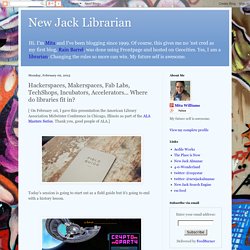
Thank you, good people of ALA.] Today’s session is going to start out as a field guide but it’s going to end with a history lesson. We’re going to start here - with a space station called c-base that found/ed in Berlin in 1995. And then we are going travel through time and space to the present day where business start-up incubator innovation labs are everywhere including CBASE which is the College of Business and Economics from the University of Guelph. But before we figure out where libraries makerspaces fit in, we’re going to use the c-base space station to go back in time, just before the very first public libraries were established around the world, so we can figure out how to go back to the future we want. But before we can talk about library makerspaces, we need to talk about hackerspaces. Fab Labs, makerspaces, etc. : Imaginer l’avenir des ateliers de fabrication numérique – Octobre 2014.
Richmond Hill's Humans of The Library points lens at patrons. If you are visiting a Richmond Hill library and are approached by someone wielding a camera, don’t hide — it’s not paparazzi.
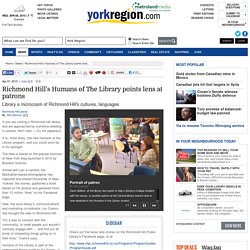
It is, more likely, the new Humans of the Library program, and you could soon be in its spotlight. The idea is based on the popular Humans of New York blog launched in 2010 by Brandon Stanton. Armed with just a camera, the Manhattan-based photographer has captured and shared thousands of New Yorkers’ life stories, published a book based on his photos and garnered more than 12 million “likes” on his Facebook page. Now, the local library’s communications and marketing co-ordinator, Ivy Cuervo, has brought the idea to Richmond Hill. “It’s a way to connect with the community, to meet people you wouldn’t normally engage with … and find out all kinds of interesting things going on in their lives,” Cuervo says.
The Humans project invites library visitors to get to know each other with a photograph and brief glimpse into what is going on in their lives. Imaginer la bibliothèque du futur. The overall purpose of the public library continues to be defined – as it was 50 years ago – as “to promote information, education and cultural activity,” but in recent years, frameworks and resources have been changing radically.

The development has gone from the classical librarian-controlled book library to a library concept that takes its starting point in the needs and interests of the citizens, and which organises offers and activities based on a far wider understanding of information than the classical general education concept. In general terms, the trend is towards more life at the library through more programming, interplay with partners, use of volunteers and the citizens' own activities. More life at the library - MODEL PROGRAMME FOR PUBLIC LIBRARIES. The overall purpose of the public library continues to be defined – as it was 50 years ago – as “to promote information, education and cultural activity,” but in recent years, frameworks and resources have been changing radically.

The development has gone from the classical librarian-controlled book library to a library concept that takes its starting point in the needs and interests of the citizens, and which organises offers and activities based on a far wider understanding of information than the classical general education concept. In general terms, the trend is towards more life at the library through more programming, interplay with partners, use of volunteers and the citizens' own activities. Les bibliothèques du futur. Q and A: Shedding light on the library of the future.
Lyn Rice of Rice+Lipka Architects in New York City has been busy giving libraries around the Big Apple a facelift over the past three years.
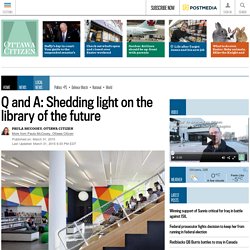
Among the firm’s notable projects was the Hamilton Grange Library Teen Center in Harlem, described as the New York Public Library’s “first full-floor dedicated teen space.” Unlike the dark, formal buildings of the past, the modern spaces Rice and his colleagues create are designed to draw not only light, but also people from all walks of life. As Ottawa moves closer to the renewal of its central library — the topic of a public discussion Tuesday night at city hall — the Citizen spoke with Rice about the evolution of libraries. Q How do you see libraries in the future? A The library is so much in demand as a new civic space, a place that has kind of gone by the wayside in previous decades. Et maintenant, que vais-je faire. Sans doute n’est-ce pas un hasard si la médiathèque de Roubaix, fleuron de la lecture publique au nord de Paris au début des années quatre-vingt, est l’un des premiers équipements à mettre en lumière le phénomène tant redouté de l’érosion des publics, qui délaissent la bibliothèque au profit d’internet. « Avoir été moderne », y a-t-il pire calamité pour un établissement dont le faste passé ne ferait qu’accuser le déclin actuel ?
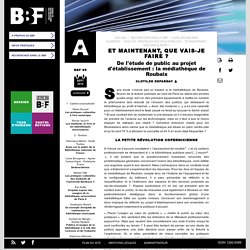
Et que voudrait dire se moderniser à une époque où il n’est plus imaginable de prendre de l’avance sur les technologies, mais où il faut à tout le moins essayer de rattraper son retard ? Comment redevenir visible pour les Roubaisiens alors même que la médiathèque est située en plein centre-ville et qu’ils sont 79 % à déclarer la connaître et 44 % à l’avoir déjà fréquentée ? La petite révolution copernicienne. Les Learning center sont des… bibliothèques universitaires modernes - J'ai écrit ce blog entre 2005 et 2018, de nombreux billets peuvent vous intéresser.
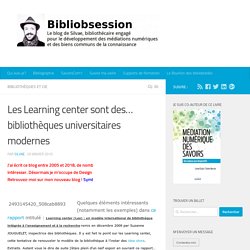
Désormais je m'occupe de Design des politiques publiques. Retrouvez-moi sur mon nouveau blog ! Symbioses Citoyennes Les missions des centres sont multiples et intégrées : documentaires, (y compris l’offre technologique), pédagogiques, sociales, un peu moins fréquemment culturelles. Expériences étrangères les plus réussies se situent dans des universités dispensant des formations. Les learning centers, ces BU nouvelle génération - Enquête sur Educpros. S'adapter aux nouveaux modes de travail des étudiants : telle est la mission confiée aux learning centers, appelés à remplacer peu à peu les bibliothèques universitaires.
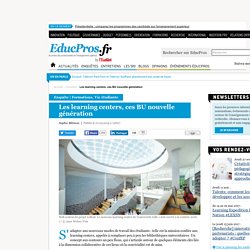
Un concept aux contours un peu flous, qui s'articule autour de quelques éléments clés liés à la dimension collaborative de ces lieux où la convivialité est de mise. Plus de postes informatiques… mais aussi des canapés et des poufs. La bibliothèque cinquième lieu, sixième lieu, etc. De façon bizarre et réitérée, les questions que je posais sur la bibliothèque troisième lieu me reviennent à travers de multiples échanges, lectures, contacts.

Tout aussi étrangement, elles se conjuguent avec des observations passionnées sur mon post-scriptum, qui promettait ma critique de la vogue du ‘learning center‘. Je l’avoue, ces questions me taraudent particulièrement, peut-être parce que me suis beaucoup consacré aux collections et aux politiques documentaires, et que ‘troisième lieu’ comme learning center posent des objectifs qui négligent justement parfois ces collections et parfois ces politiques documentaires. Prototyping the Library of the Future - Today.
Innovations en bibliothèques municipales. Biblio Remix. Lieuxdapprentissagelieuxdevieslideshare Robert. La bibliothèque publique du 21e siècle : au delà du prêt de livres / Stéphane Legault. The Future Library Thomas Frey. Les bibliothèques du futur en science fiction Tessier Sept 2011. Pourquoi notre futur dépend des bibliothèques, de la lecture et de l'imagination / Neil Gaiman. L'avenir des bibliothèques – cinq prises de position. Visages de l'avenir des bibliothèques / Claude Poissenot.